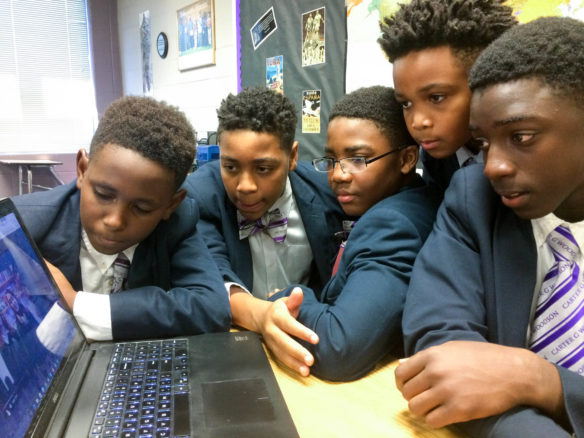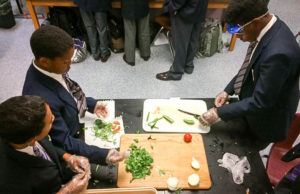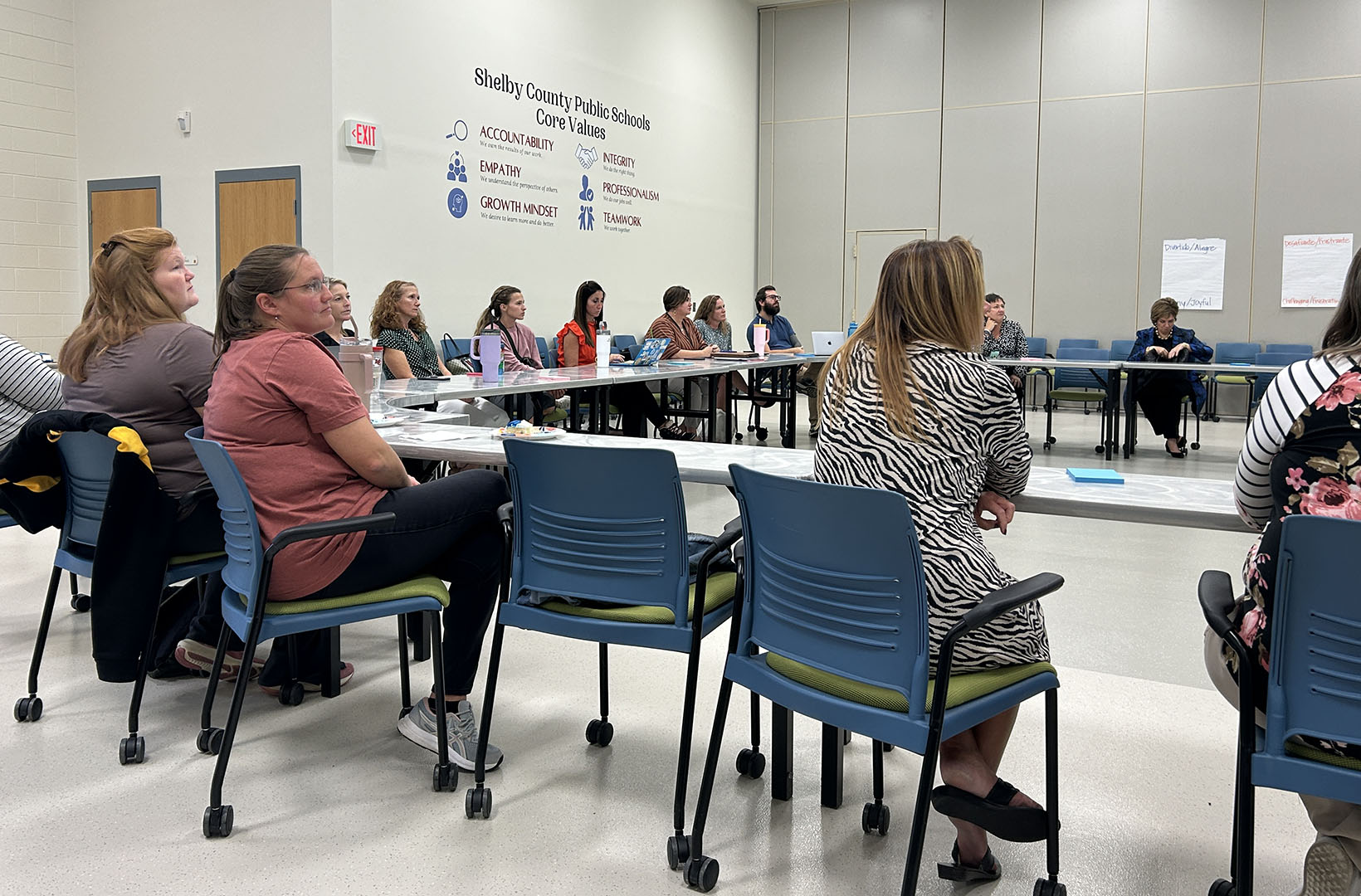
Carter G. Woodson Academy (Fayette County) 7th-grade Spanish students, from left, Elijah Maupins Floyd, Caden Johnson, Joseph Edmonds, Maxwell Clay and Xavier Brown connect virtually with San Viator School in Madrid, Spain.
Submitted photo by Ben McMaine
Ben McMaine
ben.mcmaine@fayette.kyschools.us
Teachers and students alike often fear being plunged into environments that they don’t understand. As we “go global,” we are faced with such environments.
Global competence requires us to communicate our ideas and to take action with our fellow world citizens, many of whom speak languages other than English. Therefore, it is imperative that we equip our students with the tool of bilingualism.
The American Council on the Teaching of Foreign Languages (ACTFL) recommends that language educators and their students spend at least 90 percent of class time communicating in the target language – the language being studied. This task may seem daunting, but I have seen its impact.
A few years ago, I became an ACTFL-certified oral proficiency interview tester. This required that I interview and rate the language proficiency of dozens of Spanish students. I interviewed learners from traditional K-12 Spanish programs, from Spanish immersion programs and from university Spanish classes.
What did I learn? Students from classrooms using 90 percent plus target language consistently scored at a higher proficiency level than their peers. This may seem obvious. How can we expect to learn a language without exposure?
Using only English in the world language classroom has been compared to teaching kids to swim without using water. However, faced with a classroom of blank stares, we often wonder where to start.
Recently, I spent 150 days studying Russian using Duolingo and Memrise. However, it was only after a week in Ukraine that my proficiency noticeably began to increase. Every store sign contextualized vocabulary, every voice spoke to me in Russian or Ukrainian.
How can we turn our classrooms into language-rich environments? The internet is full of pictures from the target culture. One of my colleagues teaches global competency and language through printed picture menus from Spanish-speaking countries.
For the past several years, I have worked with Fayette County’s STARTALK Chinese summer program, funded by a federal grant that provides elementary students a two-week Chinese immersion experience. One day, I walked into a 3rd-grade classroom to the chorus of Chinese voices emanating from iPads. Students were scanning QR codes, which my Chinese teacher colleague had taped to pictures on the walls. Using http://qrvoice.net/, she had connected images with the spoken word and let her walls do the teaching.

Carter G. Woodson Academy 7th-grade Spanish students, from left, Marcus Jones, William Holmes and Justin Graves prepare salsa picante, investigating cultural practices through collaboration between science and Spanish classes.
Submitted photo by Ben McMaine
Undoubtedly, the most effective method for successfully teaching world languages is for students to have certified teachers with native or native-like language proficiency. In circumstances where this is not feasible, teachers that don’t speak another language can still play a very useful role in establishing a foundation for bilingualism and global competency by increasing target language use in their classrooms through connections, virtual or otherwise, with language users and authentic materials.
As a language teacher, I realize the greatest gift I can give my students is to introduce them to experiences. I use Spanish music in my classroom and my kids love it. Authentic music has value beyond a catchy tune. It increases the target language exposure in my classroom, giving my students an authentic experience. Websites such as Zachary Jones, with primarily Spanish resources, and Yabla!, with resources in multiple languages, offer repositories of culturally authentic songs.
Real-world contexts provide simple solutions to the target language challenge, but where can educators find them? My students enjoy bringing Spanish-speaking community members into our classroom. We also have utilized heritage-language students, or students who speak Spanish at home. One year, we connected via Skype with an immersion class in town. I simply facilitated the student-driven learning.
Last year, we connected with a class in Spain. My students learned Spanish language and culture from their Spanish peers. Programs abound that can help educators make those connections, including Skype in the Classroom, Reach the World and ePals, as well as area college and university community liaisons.
As you step into my classroom, you notice that I am using pictures from Peter Menzel’s book “Hungry Planet: What the World Eats” to present a lesson about practices and perspectives relating to diets around the world. My students are beginners, which means I have to keep my language simple and comprehensible. It doesn’t require a lot of language on my part. First I ask in Spanish “What are they eating?” I can expand on the question. “How are they eating? How much does it cost? What are they wearing?” A little bit of modeling and miming, and we are on our way.
Although they are not always immediately evident, resources surround us. Authentic videos and pictures are an internet search away. Classrooms around the world bring the world and its languages into our classrooms. Our global community speaks many languages. Let’s join them!
Ben McMaine teaches Spanish at Carter G. Woodson Academy (Fayette County). He is an ACTFL-certified oral proficiency interview tester and National Network for Early Language Learning Teacher of the Year for the Kentucky chapter. He is also a part-time instructor of Spanish at the University of Kentucky.



Leave A Comment